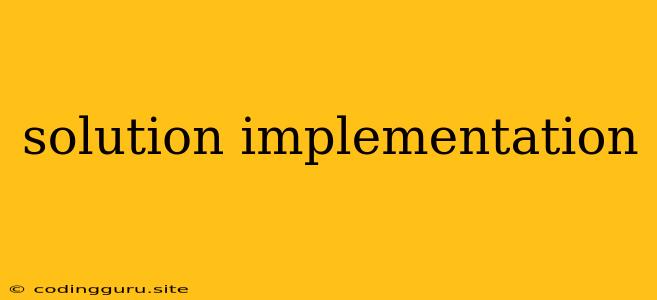The Art of Bringing Solutions to Life: A Deep Dive into Implementation
In the world of business, technology, and innovation, ideas are a dime a dozen. It's the implementation of these ideas, the transformation of concepts into tangible reality, that truly makes a difference. Solution implementation is the bridge between theoretical possibilities and practical impact, the journey from blueprints to functioning systems. But how do we successfully navigate this crucial step?
Solution implementation is not just about coding, building, or deploying. It's a complex process involving various stakeholders, meticulous planning, and careful execution. It's about understanding the nuances of the problem, designing a solution that addresses it effectively, and then putting that solution into action in a way that maximizes its benefits.
Understanding the 'Why' Behind the 'How'
Before diving into the 'how' of solution implementation, it's crucial to understand the 'why'. What is the problem we're aiming to solve? What are the desired outcomes? Who are the stakeholders involved, and what are their needs and expectations? This deep understanding of the problem and its context forms the foundation for a successful implementation strategy.
The Pillars of Effective Solution Implementation
1. Planning:
- Define the Scope: Clearly outline the boundaries of the project, identifying what's included and what's excluded.
- Establish Goals and Metrics: Set clear, measurable objectives to track progress and evaluate success.
- Develop a Roadmap: Create a detailed plan outlining the phases, timelines, and milestones of the implementation.
- Identify Resources: Allocate the necessary human capital, technology, and financial resources for each stage.
2. Design:
- Conceptualize the Solution: Translate the problem definition into a detailed solution design, taking into account technical feasibility, user needs, and business requirements.
- Choose the Right Tools and Technologies: Select tools and technologies best suited for the specific solution and the project's scope.
- Develop Prototypes: Create prototypes or pilots to test the feasibility and effectiveness of the solution before full-scale implementation.
3. Execution:
- Modular Implementation: Break down the implementation into manageable modules or phases to ensure efficient execution and minimize risks.
- Agile Approach: Embrace iterative development and continuous feedback to adapt the solution based on real-time insights.
- Effective Communication: Maintain transparent and consistent communication with stakeholders throughout the process, addressing concerns and managing expectations.
4. Monitoring and Evaluation:
- Track Progress: Regularly monitor the project's progress against the defined timelines and milestones.
- Gather Feedback: Obtain feedback from stakeholders to identify areas for improvement and optimize the solution.
- Measure Success: Evaluate the implementation against the defined goals and metrics to determine its effectiveness and impact.
Common Challenges and Best Practices
1. Lack of Clear Goals and Objectives: Without well-defined goals, it's challenging to measure success and ensure the solution truly addresses the problem.
**** Best Practice: Spend time upfront defining clear, measurable goals and objectives that align with the overall business strategy.
2. Insufficient Planning and Resource Allocation: Underestimating the complexity of the project can lead to delays, cost overruns, and project failures.
**** Best Practice: Develop a comprehensive plan, including resource allocation, timelines, and risk mitigation strategies.
3. Poor Communication and Collaboration: Communication breakdowns can lead to misunderstandings, delays, and frustrated stakeholders.
**** Best Practice: Foster open communication channels, encourage regular updates, and promote collaboration between all stakeholders.
4. Resistance to Change: Introducing a new solution can face resistance from employees who are comfortable with existing processes.
**** Best Practice: Communicate the benefits of the solution, provide adequate training, and involve employees in the implementation process.
Beyond the Technical: The Human Element of Implementation
Solution implementation is not just about technology; it's about people. Successful implementation requires building buy-in from stakeholders, engaging users, and fostering a culture of collaboration.
- User Engagement: Involve users in the design and testing phases to ensure the solution meets their needs and enhances their experience.
- Change Management: Prepare stakeholders for the changes the new solution will bring and provide training to ensure smooth adoption.
- Continuous Improvement: Foster a culture of continuous improvement by encouraging feedback, learning from mistakes, and adapting the solution based on user needs.
Conclusion
Solution implementation is the cornerstone of turning ideas into reality. It demands a meticulous blend of planning, design, execution, and ongoing monitoring. By understanding the intricacies of implementation, embracing best practices, and prioritizing the human element, organizations can successfully bring their solutions to life and achieve their desired outcomes. The journey from concept to impact is challenging but ultimately rewarding, creating tangible value and driving positive change.
